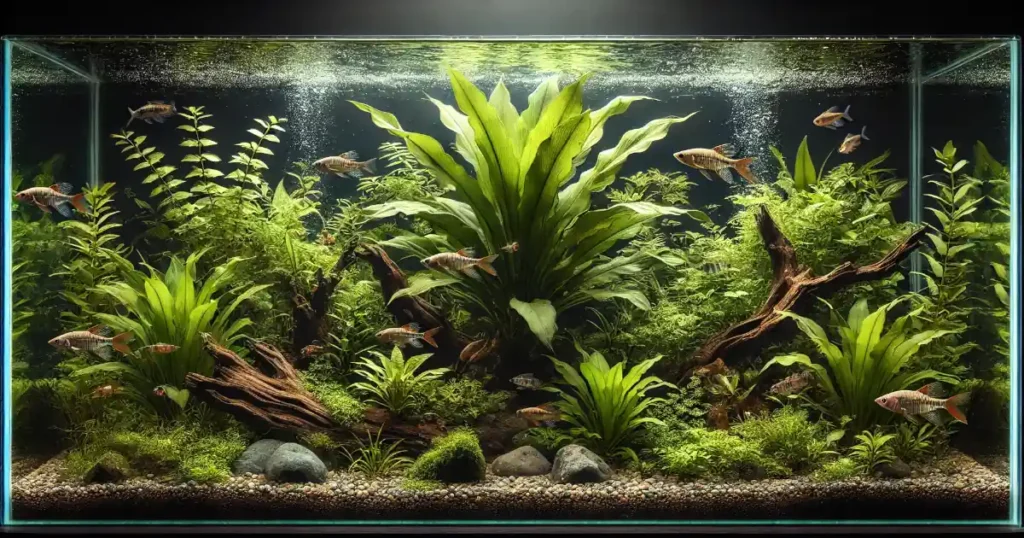I. Introduction
A. Overview of the Amazon Sword Plant
The Amazon Sword, known scientifically as Echinodorus, is one of the most iconic and widely used aquatic plants in the aquarium hobby. With its broad, sword-shaped leaves that can grow to impressive lengths, the Amazon Sword is not just a plant but a statement piece in any freshwater aquarium. Originating from the lush and diverse Amazon Basin, this plant has adapted to a variety of aquatic environments, making it a versatile choice for aquarists of all levels.
B. Importance in the Aquarium Hobby
The popularity of the Amazon Sword among aquarists is undeniable. Its aesthetic appeal, combined with its relatively easy care requirements, makes it a go-to choice for both beginners and experienced hobbyists. This plant plays a crucial role in aquascaping, where it is often used to create a natural, jungle-like environment. Beyond its beauty, the Amazon Sword contributes significantly to the overall health of the aquarium ecosystem. It helps oxygenate the water, provides shelter and breeding grounds for fish, and can even assist in the filtration process by absorbing excess nutrients.
C. Purpose of the Article
This article aims to provide a thorough understanding of the Amazon Sword, covering everything from its physical characteristics to its role in aquascaping. Whether you’re a novice looking to add your first plant to an aquarium or a seasoned aquarist seeking to expand your knowledge, this guide will offer valuable insights into the care, maintenance, and propagation of the Amazon Sword.
II. Detailed Description of the Amazon Sword
A. Physical Characteristics
The Amazon Sword is characterized by its large, elongated leaves that resemble a sword, hence the name. These leaves can vary in color from light green to dark green, depending on the specific species and growing conditions. Typically, the leaves grow in a rosette pattern, with new leaves emerging from the center of the plant. In a well-maintained tank, the Amazon Sword can reach heights of up to 20 inches, making it a dominant feature in any aquarium.
B. Species Variations
Within the Echinodorus genus, several species are commonly referred to as Amazon Swords. The most popular include Echinodorus bleheri and Echinodorus amazonicus. While both species share similar characteristics, they differ slightly in size, leaf shape, and preferred conditions. For instance, Echinodorus bleheri tends to have broader leaves and grows slightly taller, making it ideal for larger tanks. On the other hand, Echinodorus amazonicus has narrower leaves and is more suited for mid-sized aquariums. Additionally, there are hybrid varieties available, which offer unique traits such as enhanced color or more compact growth.
III. Ideal Tank Setup for Amazon Sword
A. Aquarium Size Requirements
When it comes to housing an Amazon Sword, tank size is an important consideration. Due to its potential size, a tank of at least 20 gallons is recommended, although larger tanks allow for more natural growth and better stability. In smaller tanks, careful placement is necessary to ensure the plant has enough space to grow without overshadowing other plants or crowding the tank’s inhabitants.
B. Substrate Selection
A nutrient-rich substrate is crucial for the Amazon Sword, as it is a heavy root feeder. The roots of this plant extend deep into the substrate, drawing essential nutrients that are vital for healthy growth. Recommended substrate types include laterite, aqua soil, or any other substrate rich in iron and other micronutrients. For best results, layer the substrate, placing a nutrient-dense layer at the bottom and covering it with a softer, more decorative layer to hold the roots in place.
C. Lighting Needs
The Amazon Sword thrives in moderate to high lighting. Adequate light not only promotes healthy growth but also enhances the plant’s color, making the leaves appear more vibrant. A photoperiod of 8 to 10 hours per day is ideal. Both LED and fluorescent lights can be used, but the intensity and spectrum should be chosen based on the specific needs of your tank. For deeper tanks, stronger lights may be necessary to ensure that the lower leaves receive sufficient light.
D. Water Parameters
Maintaining optimal water conditions is key to the health of the Amazon Sword. The ideal temperature range is between 72°F and 82°F (22°C to 28°C), with a pH level of 6.5 to 7.5. Water hardness should be kept at a moderate level, as overly hard or soft water can impact the plant’s ability to absorb nutrients. Regular water changes are important to prevent the buildup of waste products and to ensure that the plant has access to fresh, clean water.
E. CO2 and Fertilization
While the Amazon Sword can survive without additional CO2, supplementing it with CO2 will significantly enhance its growth and overall health. CO2 injection systems are available and can be easily integrated into most aquariums. In addition to CO2, regular fertilization is recommended. Liquid fertilizers can be added directly to the water, while root tabs can be placed near the plant’s base to provide a steady supply of nutrients. Be sure to include both macro and micronutrients in your fertilization regimen to meet the plant’s needs.
IV. Planting and Care Tips
A. How to Plant the Amazon Sword
Planting an Amazon Sword is straightforward, but a few key steps will ensure success. Begin by selecting a location in the tank where the plant will have ample room to grow. Dig a small hole in the substrate and place the plant’s roots into the hole, covering them gently with the substrate. The crown of the plant (where the leaves meet the roots) should be slightly above the substrate to prevent rot. Space multiple Amazon Swords at least 4 to 6 inches apart to allow for full growth and to avoid competition for nutrients.
B. Regular Maintenance
Regular maintenance is essential to keep the Amazon Sword healthy and vibrant. Pruning is one of the most important tasks, as it prevents the plant from becoming overgrown and ensures that light reaches all parts of the plant. Remove any yellowing or damaged leaves, cutting them close to the base. To manage algae growth, reduce light intensity or duration, and consider adding algae-eating fish or invertebrates to the tank. Monitoring for nutrient deficiencies is also crucial; signs such as yellowing leaves or stunted growth indicate a need for more fertilizer or CO2.
C. Common Problems and Solutions
Like any plant, the Amazon Sword can face several challenges. Yellowing leaves are often a sign of nutrient deficiency, particularly a lack of iron. Adding an iron-rich fertilizer can resolve this issue. Root rot, caused by the plant being planted too deeply or poor substrate conditions, can be prevented by ensuring the crown remains above the substrate and by using a well-draining substrate. Pests, such as snails or algae eaters, can damage the plant by eating the leaves. To manage pests, consider introducing natural predators or using a biological control method.
V. Propagation of Amazon Sword
A. Natural Propagation Methods
The Amazon Sword propagates naturally through runners, which are horizontal stems that grow out from the base of the plant. These runners produce small plantlets that can eventually be separated and planted elsewhere in the tank. To identify a runner, look for a thin stem extending from the main plant with several small leaves forming at intervals along its length.
B. Artificial Propagation Techniques
In addition to natural propagation, artificial methods can be used to multiply the Amazon Sword. One common technique involves cutting a healthy leaf with a portion of the root attached and planting it in a new location. This method requires careful handling to avoid damaging the delicate roots. For best results, perform artificial propagation during the growing season when the plant is most vigorous.
C. Challenges in Propagation
Propagation can be challenging, especially for beginners. Young plants tend to grow slowly, and it may take several weeks or even months for them to reach a size suitable for replanting. Ensuring the health of the mother plant is also important, as over-harvesting plantlets can weaken it. Providing adequate nutrients, CO2, and light will support both the mother plant and the new plantlets.
VI. Role of Amazon Sword in Aquascaping
A. Aesthetic Contributions
In aquascaping, the Amazon Sword is often used as a background or centerpiece plant. Its tall, flowing leaves create a natural look that mimics the dense vegetation found in the Amazon Basin. The plant’s size and structure make it ideal for filling large spaces, and its vibrant green color contrasts beautifully with other plants and hardscape elements.
B. Ecological Benefits
Beyond its visual appeal, the Amazon Sword provides several ecological benefits. It helps oxygenate the water, which is vital for the health of fish and other tank inhabitants. The plant also absorbs excess nutrients, such as nitrates, which can prevent algae blooms and improve water quality. Additionally, the dense foliage offers shelter and breeding grounds for fish, especially for species that prefer a more secluded environment.
C. Example Aquascape Designs
The Amazon Sword can be used in a variety of aquascape designs. In a classic Amazon biotope, it serves as the primary plant, surrounded by driftwood and other native species. In a Dutch-style aquascape, the Amazon Sword can be used to create height and depth, contrasting with low-growing plants and creating a layered effect. For low-tech aquariums, where CO2 supplementation and high-intensity lighting are not used, the Amazon Sword remains a viable option due to its adaptability and hardiness.
VII. Compatibility with Fish and Other Tank Inhabitants
A. Ideal Tank Mates
The Amazon Sword is compatible with a wide range of fish species. Peaceful community fish, such as tetras, guppies, and angelfish, thrive alongside this plant. Invertebrates, such as shrimp and snails, also benefit from the shelter provided by the dense leaves. The plant’s ability to tolerate a variety of water conditions makes it suitable for different setups, from community tanks to species-specific tanks.
B. Fish to Avoid
While the Amazon Sword is generally hardy, certain fish species can pose a threat. Large cichlids, such as Oscars, are known to uproot plants and may damage the Amazon Sword by nipping at the leaves. Herbivorous fish, like goldfish, may also eat the leaves, leading to significant damage. To protect the plant, consider placing it in a tank with less destructive species or using a plant guard.
C. Amazon Sword in Community Tanks
In a community tank, the Amazon Sword helps create a balanced ecosystem. It provides hiding spots for shy fish, reduces stress by offering a more natural environment, and supports the biological filtration process. When planting in a community tank, consider the needs of all inhabitants and ensure that the plant does not overcrowd the tank or block essential swimming areas.
VIII. Troubleshooting Common Issues
A. Growth Problems
Stunted growth is a common issue with the Amazon Sword, often caused by a lack of nutrients or insufficient light. To address this, increase the frequency of fertilization or upgrade the lighting system. Overcrowding can also stunt growth, so ensure that the plant has enough space to expand. Adapting to new tank conditions can be stressful for the plant, leading to temporary stunted growth. Allow the plant time to acclimate before making major adjustments.
B. Disease Management
The Amazon Sword is relatively resistant to diseases, but it can still fall victim to common aquatic plant ailments. Fungal infections, characterized by fuzzy growths on the leaves, can be treated with antifungal medications or by improving water quality. Bacterial infections, which cause rotting leaves or stems, require prompt removal of affected parts and treatment with antibacterial agents. Quarantining new plants before adding them to the tank can prevent the spread of diseases.
C. Pest Control
Pests such as snails and algae can be a nuisance for the Amazon Sword. Snails may eat the leaves, causing holes and other damage. To control snail populations, consider introducing natural predators, such as assassin snails, or manually removing them. Algae growth can be managed by reducing light intensity, controlling nutrient levels, and introducing algae-eating fish or invertebrates. In severe cases, chemical treatments may be necessary, but these should be used sparingly to avoid harming other tank inhabitants.
IX. Conclusion
A. Recap of Key Points
The Amazon Sword is a versatile and resilient plant that offers both aesthetic and ecological benefits to freshwater aquariums. Understanding its care requirements and potential challenges will help ensure its success in any tank setup. From its role in aquascaping to its compatibility with various fish species, the Amazon Sword is an excellent choice for aquarists looking to create a thriving, natural environment.
B. Final Tips for Success
For beginners, the Amazon Sword is a forgiving plant that can adapt to a range of conditions. Start with a nutrient-rich substrate, provide adequate lighting, and consider CO2 supplementation for best results. Regular maintenance, including pruning and fertilization, will keep the plant healthy and vibrant.
C. Call to Action
Whether you’re setting up your first aquarium or looking to enhance an existing one, the Amazon Sword is a plant worth considering. Its beauty, resilience, and ecological contributions make it a valuable addition to any aquatic setup. Try incorporating the Amazon Sword into your aquarium and experience the benefits it brings. Share your experiences or ask questions in online forums or communities to further enhance your aquascaping skills.
Frequently Asked Questions (FAQs)
What is the ideal tank size for an Amazon Sword plant?
A minimum of 20 gallons is recommended, but larger tanks allow for more natural growth and stability.
How often should I fertilize my Amazon Sword plant?
Regular fertilization is essential; use liquid fertilizers weekly and root tabs monthly for optimal growth.
Can the Amazon Sword grow without CO2 supplementation?
Yes, it can grow without CO2, but adding CO2 will enhance its growth and health significantly.
What are common signs of nutrient deficiencies in an Amazon Sword?
Yellowing leaves and stunted growth are typical indicators of nutrient deficiencies, especially a lack of iron.
Which fish species are compatible with the Amazon Sword plant?
Peaceful community fish like tetras, guppies, and invertebrates like shrimp thrive alongside this plant.
How do I propagate the Amazon Sword plant?
It propagates naturally through runners and plantlets, which can be separated and replanted in other areas of the tank.







